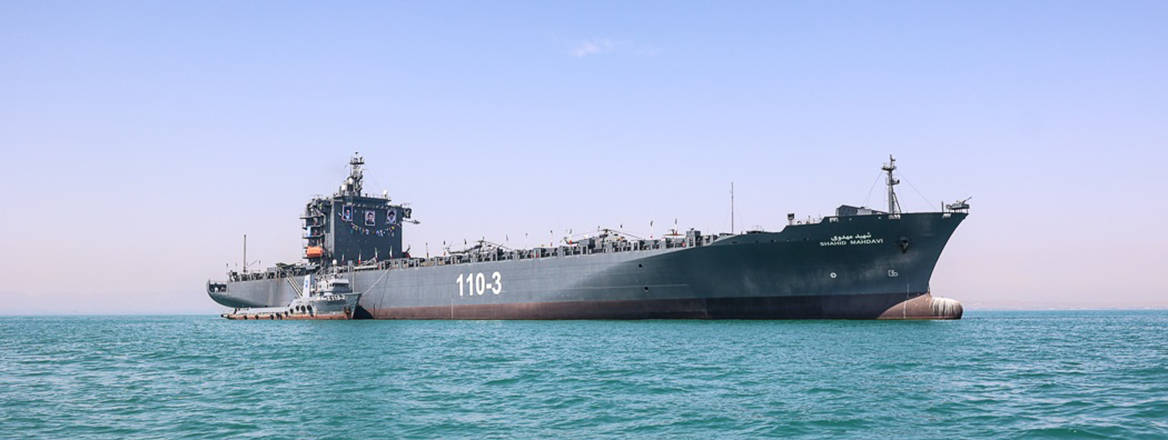RUSI
|
|
Iran’s Modern Q-Ship: A Threat from New Quarters
In January 2024 Iran successfully tested the launch of ballistic missiles housed in cargo containers from the deck of a container ship, giving it the ability to launch missile strikes from new and previously unexpected vectors and from a highly survivable platform. This has significantly increased Iran’s naval strike effectiveness.

In January 2024, Iran successfully tested the launch of two Fateh-class ballistic missiles from containers on the deck of Shahid Mahdavi, a container ship purchased in March 2023. The most likely missile variant used was the Fateh-110, which has a range of 200–500 km, as it has already been containerised. This represents a significant increase in the Islamic Revolutionary Guard Corps Navy’s (IRGCN’s) capability to deliver naval strike.
The deployment of Fateh missiles on the Shahid Mahdavi will allow the IRGCN to launch these missiles from new and previously unexpected locations. Iran’s adversaries will now have to reexamine their air defence plans, and will need to either reprioritise existing air defence assets or purchase new ones. Reprioritising current air defence assets will degrade capabilities defending existing attack vectors, but will not increase defence spending, whereas procuring new air defence assets will require additional defence spending as well as more people to operate them. In either case, Iran has imposed significant additional costs on its adversaries by developing this capability.
Further increasing the Shahid Mahdavi’s utility is the fact that container ships are more resilient than any frigate or destroyer. This was shown notably in the 1987 Bridgeton Incident, where the Bridgeton struck a sea mine placed in the path of a merchant convoy being escorted by the US Navy. The US escorts did not have any countermine equipment with them, so they and the other ships in the convoy followed the Bridgeton through the rest of the mine field. This ensured that the way was clear, as the Bridgeton was assessed as able to withstand subsequent mine strikes. This proved valuable as the USS Samuel Roberts struck a similar mine a few months later in 1988 and was irreparably damaged. Contrastingly, the Bridgeton was repaired and operated for many years afterwards, only being scrapped in 2002.
Iran has gained a valuable capability that will cause significant planning difficulties for its adversaries and, if deployed in a conflict, potentially significant damage
Similarly, over the past few months, cargo ships in the Red Sea have come under repeated attack from anti-ship ballistic missiles (ASBMs). Several ships, like the M/V Gibraltar Eagle and the M/V Huang Pu, have sustained hits from ASBMs whose warheads are around quadruple the size of the Neptune missiles that sank the Moskva in 2022. These ships only suffered minor damage with no casualties, and were able to continue on their way. This along with the Bridgeton Incident shows that there is a significant difference in the survivability of a warship compared to that of a container ship.
Furthermore, this increase in capability and resilience will have been purchased for much less than what a purpose-built ship would cost. In the 1990s, the US explored building a ship with a large number of missile silos with the Arsenal Ship concept. It was predicted that each ship would cost between $500 million and $800 million. By comparison, a similar ship to the Shahid Mahdavi is currently on sale for $18.5 million. Given this price, it is most likely that the procurement cost of the Shahid Mahdavi was less than $20 million. This figure is exclusive of the cost of refitting the Shahid Mahdavi to a military specification, but even if that cost equalled the assessed maximum price of the ship, it would still represent a significant saving compared to procuring a purpose-built vessel.
Additionally, further savings will have been realised through the size of the crew. A merchant vessel of this size would typically have a crew size of 25. A military vessel would have more personnel functions, like weapons officers and security, so the crew would need to be larger. However, this is unlikely to exceed the 50 that the Arsenal Ship concept projected. This would be little more than a third of the crew complement of a Moudge-class frigate. Thus, the Shahid Mahdavi has substantially greater strike capacity than a Moudge-class frigate while being significantly cheaper to operate.
In sum, Iran has gained a valuable capability that will cause significant planning difficulties for its adversaries and, if deployed in a conflict, potentially significant damage. It has also increased the resilience of Iran’s naval strike capabilities. This has been achieved at a far cheaper cost than what would be needed for a purpose-built ship with the same capability. Monitoring the further development of the Shahid Mahdavi and the IRGCN overall should be a priority to ensure that their capabilities are not underestimated.
The views expressed in this Commentary are the author’s, and do not represent those of RUSI or any other institution.
Have an idea for a Commentary you’d like to write for us? Send a short pitch to commentaries@rusi.org and we’ll get back to you if it fits into our research interests. Full guidelines for contributors can be found here.
Original article link: https://rusi.org/explore-our-research/publications/commentary/irans-modern-q-ship-threat-new-quarters


